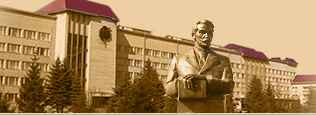BIOCHEMISTRY OF PODZOLIC PROCESS IN CAMBISOLS FORMED ON THE CARPATHIAN ELEVO-DELLUVIAL FLISH.
The main process in the formation of podzols is podzolisation. Podzolisation is a complex process (or number of sub-processes) in which organic material and soluble minerals (commonly iron and aluminium) are leached from the A and E horizons to the B horizon. It involves mobilization and precipitation of dissolved organic matter, together with aluminum and iron as they leach down from the A and E horizons to the B horizon.Through this process the overlying eluvial horizons are bleached. The complexes move to the brown, red or black horizon, which consist of cemented sesquioxides and/or organic compounds. Podzolisation occurs under low pH values. In the Carpathian region podzolic process is actively manifest in the soils formed on the deluvial deposits of Prykarpattia. Brown-podzolic soil and sod-podzolic soils are formed here. At the same time, in brown soils of midlands and highlands, which were formed on eluvial-deluvial of Carpathian flysch, podzolisation hardly manifested. Found that the liquid phase brownsoils a «neutral» than solid, as its main component is calcium solutions (fulvaty and hydrocarbons). This has a fundamental difference from the brown soils and podzolic soils. For the high content of biogenic calcium in the litter, in the upper horizon of brown soils complexes with humic substances seskvioxides further bind biogenic calcium to form complex heteropolar organic mineral salts. According to the law of chemical kinetics, reactive acid groups of humic acids primarily associated with seskvioxides, forming a stable chelate compounds. The ability of these complexes to bind Ca2+ free reactive groups is small. This may explain the low levels of exchange of Ca2+ on the unit of humus in the upper horizon of brown earth. Due to the low ability to bind biogenic humus Ca supplied from the bedding soil in large quantities (possibly very large). Can be explained by the possibility of permanent migration profile in a large number of biogenic Ca. So, thanks to a deep root system, migration of Ca2+ in burozems is not one-sided. It carries out continuous intensive biological and biogeochemical cycling of Ca2+ in the soil profile. Podzolized brown earth can occur only in cases where an almost continuous migration profile solutions Ca2+ weaken.
Keywords: podzolisation, mountain brown soils (Cambisols), acid-base properties, Ukrainian Carpathians.
References:
- Aleksandrova L. N. Orhanycheskoe veshchestvo pochvy y protsessy eho transformatsyy. – L.: Nauka, 1987.
- Babanyn V. F. Yssledovanye vzaymodeystvyya humynovoy kysloty s katyonamy metallov metodamy elektronnoho paramahnytnoho rezonansa y mahnytnykh yzmerenyy / V. F. Babanyn, S. S. Ermylov, V. V. Morozov, D. S. Orlov, Y. H. Fal’kov // Pochvovedenye. 1983. # 7. – S. 115–119.
- Barannyk A. V. Kyslotno-osnovni vlastyvosti hirs’ko-luchnykh burozemnykh gruntiv (Cambic Umbrisols) Chornohirs’koho masyvu ta yikh transformatsiya u protsesi antropohennoyi diyal’nosti [Tekst] / A. V. Barannyk, S. P. Poznyak // Naukovi zapysky Ternopil’s’koho natsional’noho pedahohichnoho universytetu imeni Volodymyra Hnatyuka. Seriya: heohrafiya. – Ternopil’ : SMP «Tayp». – #1 (vypusk 38). – 2015. – S. 33-37.
- Hoholev Y. N. Burye horno-lesnye pochvy Sovetskykh Karpat. dys. d-ra s.-kh. nauk. – L’vov, 1965. – 40 s.
- Hoholev Y. N. Pochvy Ukraynskykh Karpat / Y. N. Hoholev // Pryroda Ukraynskoy SSR. Pochvy. – Kyev: Nauk. dumka, 1986. – S. 145–171.
- Zaydel’man F. R. Formy kyslotnoho hydrolyza y hleeobrazovanyya y ykh rol’ v voznyknovenyy svetlykh kyslykh elyuvyal’nykh (podzolystykh) horyzontov / F. R. Zaydel’man // Pochvovedenye. 2010. # 4. – S. 387–398.
- Kanyvets V. Y. Burozemy y dernovo-burozemnye kyslye pochvy / V. Y. Kanyvets // Pochvy Ukrayny y povyshenye ykh plodorodyya. T. 1. – K.: Urozhay, 1998. – S. 251–256.
- Kovalyshyn D. Y. Sovremennoe proyavlenye podzoloobrazovatel’noho protsessa v leso-luhovoy zone USSR / D. Y. Kovalyshyn // Pochvovedenye. 1990, 6. – S. 5–19.
- Krupenykov Y. A. Vernadskyy – Dokuchaev. Byosfera – pochva (K 125-letyyu so dnya rozhdenyya V. Y. Vernadskoho) / Y. A. Krupenykov // Pochvovedenye. 1988, # 7. – S. 5–14.
- Pan’kiv Z. P., Poznyak S. P. Dernovo-pidzolysti poverkhnevo-ohleyeni grunty pivnichno-zakhidnoho Peredkarpattya. – L’viv: Merkator, 1998. – 130 s.
- Poznyak S. P. Gruntovyy pokryv / Poznyak S.P., Kit M.H., Vyshnevs’kyy Y.Ya., Papish I. Ya., Shuber P. M. // Bioriznomanittya Karpat·s’koho biosfernoho zapovidnyka. – K: Interekotsentr, 1997. – S. 80–95.
- Sokolova T. A. Protsessy razrushenyya kvartsa, amorfnыkh myneralov kremnezema y polevykh shpatov v model’nykh opytakh y v pochvakh: vozmozhnye mekhanyzmy, skorost’, dyahnostyka (analyz lyteraturы) / T. A. Sokolova // Pochvovedenye. 2013. # 2, S. 201–218.
- Sokolova T. A., Dronova T. Ya., Tolpeshta Y. Y. Hlynystye myneraly v pochvakh: Uchebnoe posobye. – Tula: Hryf y K, 2005. – 336 s.
- Shuber P. M. Stan i problemy vyvchennya henezysu gruntiv Ukrayins’kykh Karpat / P. M. Shuber // Visnyk L’vivs’koho universytetu: Henezys, heohrafiya i ekolohiya gruntiv. Vyp. 23. 1998. – S. 286–292.
- Shuber P. M. Grunty pryrodno-terytorial’nykh kompleksiv Ukrayins’kykh Karpat / P. M. Shuber // Visnyk L’vivs’koho universytetu: Seriya heohrafichna. Vyp. 25. 1999. – S. 79–82.
FULL TEXT:
